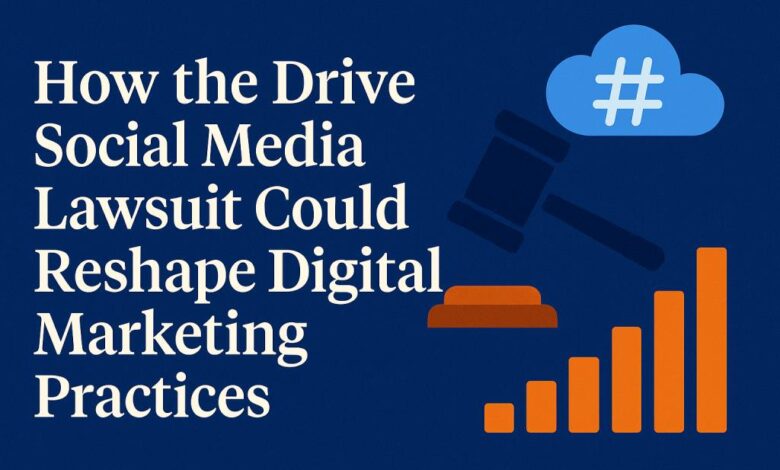
How The Drive Social Media Lawsuit Could Reshape Digital Marketing Practices
In an era where performance‑based marketing reigns supreme, the emergence of the drive social media lawsuit has sent shockwaves through digital agencies and in‑house teams alike. What began as isolated complaints about billing discrepancies and overstated deliverables has evolved into a landmark legal battle, challenging the very foundations of how agencies promise and measure campaign success.
For marketers, this lawsuit is anything but academic. It touches on core practices-contractual transparency, data integrity, and client trust and foreshadows a future in which performance guarantees and opaque reporting could land agencies in court. Understanding the contours of this case, its legal underpinnings, and its potential industry ramifications is crucial for every professional tasked with selecting, managing, or auditing digital‑marketing partnerships.
By the end of this deep‑dive, you’ll have a clear roadmap for navigating performance‑based engagements, turning legal risk into a competitive advantage rather than a looming liability.
Background on Drive Social Media: From Rising Star to Legal Target
The Origin Story
Established in 2017, Drive Social Media rapidly found its place in the competitive world of paid social advertising. Leveraging a proprietary suite of analytics tools and an agile campaign‑optimization engine, the company promised advertisers rapid scale, precise audience targeting, and transparent, ROI‑driven results. Within three years, Drive Social Media’s annual revenue ballooned from under $2 million to more than $50 million fuelled by high‑profile marquee clients in e‑commerce, direct‑to‑consumer retail, and subscription services.
Key to its success was a bold guarantee: if the platform failed to deliver agreed KPIs whether cost‑per‑acquisition (CPA), return‑on‑ad‑spend (ROAS), or monthly new‑user targets, clients could claim a rebate or fee reduction. This performance guarantee, paired with real‑time dashboards, made Drive Social Media an attractive alternative to traditional retainers.
Early Warnings and Plaintiffs’ Allegations
By late 2022, whispers of client dissatisfaction began surfacing. Advertisers reported:
- Discrepancies between dashboard and billing data: Claimed conversions on Drive’s platform didn’t match actual payment processor records.
- Unattainable deliverables: Targets were allegedly set unreasonably low, inflating apparent performance.
- Lack of auditability: Clients struggled to obtain raw data or third‑party verification, calling into question the platform’s proprietary counts.
Several mid‑sized DTC brands formally complained in early 2023, seeking contract refunds under the performance‑guarantee clauses. When negotiations failed, they banded together filing the consolidated drive social media lawsuit in Federal Court in August 2023, alleging breach of contract, fraudulent misrepresentation, and violations of consumer‑protection statutes.
Legal Foundations: Understanding the Claims in the Drive Social Media Lawsuit
To appreciate the full stakes, we must unpack the legal theories at the heart of the case:
1. Breach of Contract
At its core, the lawsuit hinges on alleged breaches of express performance‑guarantee clauses. Plaintiffs contend that Drive Social Media:
- Failed to deliver guaranteed KPIs in multiple reporting periods.
- Refused or delayed rebates owed under the force‑majeure and “performance failure” clauses.
- Mischaracterized contractual definitions, exploiting ambiguous language around “qualified conversions.”
2. Fraudulent Misrepresentation
Beyond pure contract law, plaintiffs allege that Drive executives made affirmative false statements presenting inflated conversion data, overstating ad‑optimization methodologies, and promising audit access that was never delivered. To prevail on fraud, they must show:
- A false representation of material fact
- Knowledge of its falsity (scienter)
- Intent to induce reliance
- Justifiable reliance by clients
- Damages resulting from that reliance
3. Violations of Consumer‑Protection & Data‑Privacy Statutes
Several class‑action counts invoke state consumer‑protection laws (e.g., California’s False Advertising Law, New York’s General Business Law § 349) and federal statutes regulating digital‑marketing disclosures. Plaintiffs also question Drive’s handling of user‑level data suggesting potential breaches of GDPR and CCPA obligations by sharing raw audience data without proper consent.
Timeline & Key Players: How the Case Unfolded
| Date | Event | Actors Involved |
| April 2022 | First informal client grievances recorded in internal Drive logs. | Drive account managers; DTC advertisers |
| January 2023 | Three clients formally demand rebates under performance‑guarantee clauses. | Plaintiffs’ counsel; Drive legal department |
| August 15, 2023 | Consolidated complaint filed: “Drive Social Media Lawsuit” on Docket No. 23‑4567. | Plaintiffs: Apex Brands, Nova Health, LyraCo |
| October 5, 2023 | Motion to dismiss filed by Drive Social Media, arguing lack of contractual breach and sufficiency of fraud allegations. | Lead defense counsel (Harrison & Lee LLP) |
| December 2023 | Court grants limited discovery; permits amendment of allegations around misrepresentation. | U.S. District Judge Caroline N. Reyes |
| March 2024 | Plaintiffs amend complaints to include new data‑privacy count under CCPA. | Plaintiffs’ attorneys (Green & Morales PC) |
| June 2024 | First depositions conducted; key Drive executives deposed on data‑validation processes. | Drive CTO; Director of Analytics |
| September 2024 | Expert‑witness disclosures exchanged—plaintiffs’ expert on ad‑tech integrity; defense expert on analytics methodology. | Dr. Serena Koh (plaintiff); Prof. Rajiv Patel (defense) |
| January 2025 | Mediation sessions held; parties negotiate potential settlement framework. | Mediator Hon. Marcus J. Ellis (Ret.) |
| April 2025 | Negotiations for a settlement have failed, and a pre-trial briefing is set for August 2025. | Both parties finalize pre‑trial motions |
Key Individuals & Firms
- Plaintiffs: Apex Brands, Nova Health, LyraCo collectively alleging $25 million in damages.
- Defense: Drive Social Media (CEO James Holloway; CTO Alicia Wu), represented by Harrison & Lee LLP.
- Judiciary: U.S. District Judge Caroline N. Reyes overseeing case management.
Transparency Under Fire: Impacts on Agency‑Client Trust
Erosion of Confidence in Performance Guarantees
The allure of “pay‑for‑performance” models has historically rested on two pillars: crystal‑clear reporting and fair remediation when targets aren’t met. However, the lawsuit against social media highlights deep-rooted flaws in the system:
- Opaque Algorithms
- Agencies often treat bid‑optimization engines and attribution models as proprietary “black boxes.”
- Clients lack the technical means to verify claimed efficiencies or audit raw click‑and‑conversion logs.
- Asymmetric Information
- Agencies have much greater access to data and are more skilled in analytics.
- Clients must rely on summarized dashboards, unable to challenge questionable figures.
- High Stakes of Dispute Resolution
- Contractual remedies, rebates, fee credits only address financial losses, not reputational harm.
- Litigation costs can dwarf potential recoveries, disincentivizing small to mid‑sized advertisers from pushing back.
A Wake‑Up Call for Marketers
Brands taking performance guarantees at face value may soon face heightened skepticism from procurement and legal teams. Before signing on the dotted line, every marketing leader must ask:
- Can I audit underlying data streams and attribution logic?
- What constitutes a “qualified conversion” or “valid engagement”?
- How will billing disputes be resolved through arbitration or court?
Contractual Best Practices: Lessons for Drafting Clear Service Agreements
Based on the pitfalls underscored by the drive social media lawsuit, here are ten actionable clauses and strategies to embed into your next agency contract:
- Precise Metric Definitions
- Clearly explain the meanings of terms: “click,” “impression,” “attribution window,” “qualified lead,” and so on.
- Include calculation formulas or reference third‑party tracking methodologies.
- Right to Audit
- Grant clients access to raw click, conversion, and billing logs.
- Specify the frequency (e.g., quarterly) and scope (e.g., campaign‑level data) of audits.
- Audit Cost Allocation
- If the audit reveals discrepancies over a material threshold (e.g., 5%), agency bears audit fees.
- Otherwise, the client covers the cost deterring frivolous audits.
- Performance‑Guarantee Triggers
- Tie rebates or fee reductions to objectively measurable shortfalls (e.g., “CPA exceeds target by >15%”).
- Avoid vague language like “reasonable effort” or “best practices.”
- Force‑Majeure & Delay Provisions
- Clearly carve out events beyond the agency’s control (e.g., platform outages, budget caps).
- Distinguish between delays (reschedule) and failures (rebate).
- Data‑Privacy Compliance Warranty
- Agency warrants adherence to applicable laws (GDPR, CCPA, etc.).
- Indemnification for third‑party fines or consumer claims arising from non‑compliance.
- Escalation & Dispute Resolution Pathway
- Define a structured escalation: account manager → senior director → mediation → arbitration.
- Avoid surprise litigation by requiring good‑faith mediation first.
- Termination Rights
- Allow termination for “material breach” with a 30‑day cure period.
- Clarify financial obligations on termination (prorated fees prorated, data delivery).
- Reporting Cadence & Format
- Specify frequency (weekly, monthly) and format (dashboard, CSV export) of performance reports.
- Include SLA for report delivery times (e.g., within five business days).
- Third‑Party Verification Option
- Include a clause allowing hire of an independent auditor at either party’s discretion.
- Define how findings translate into fee adjustments or contract extensions.
Embedding these provisions protects both sides ensuring transparency, setting clear expectations, and reducing the likelihood that disagreements escalate into multi‑million‑dollar lawsuits.
Performance‑Based Marketing Revisited: Shifting Industry Standards
Reevaluating Fee Structures
The drive social media lawsuit forces agencies and clients to rethink the merits and drawbacks of conventional pricing models:
- Flat Retainer + Bonus
- Base fees cover labor; performance bonus incentivizes outperformance.
- Mitigates extreme swings in agency compensation tied solely to variables beyond their control.
- Tiered Percentage of Ad Spend
- Standard 15–20% of media budget; simplicity favors large enterprise clients.
- Encourages agencies to grow spend—but may lead to inefficiencies or overspending.
- Project‑Based Pricing
- Fixed fees for specific deliverables (creative assets, strategy audits).
- Decouples agency pay from media spend and performance volatility.
Most forward‑thinking organizations will blend these: a stable retainer, modest performance bonus, and scoped project fees balancing risk, reward, and accountability.
Toward Unified Reporting Standards
One clear lesson from the drive social media lawsuit is that inconsistent attribution windows, click‑vs. view‑through definitions, and non‑standardized dashboards create fertile ground for disputes. Industry bodies and consortia may soon propose:
- Standard Attribution Windows (e.g., 7‑day click, 1‑day view)
- Uniform Conversion Counting Rules (e.g., de‑duplication methods, cross‑device stitching)
- Benchmarking & Audit Protocols akin to financial‑audit standards (e.g., SOC 2 for ad platforms)
Agencies that adopt transparent, externally validated reporting frameworks will gain a competitive edge and shield themselves from future litigation risk.
Data Privacy & Compliance: Heightened Scrutiny Ahead
The drive social media lawsuit isn’t solely about billing and KPIs it also spotlights data‑privacy pitfalls. As regulators and privacy advocates tighten the screws, marketers must heed these requirements:
- Explicit Consent for Data Collection & Sharing
- Clearly state how user‑level data will be captured, processed, and transferred to third parties.
- Provide opt‑out mechanisms and honor Do‑Not‑Sell requests under CCPA.
- Anonymization & Aggregation Standards
- Avoid sharing PII in dashboards or API feeds.
- Adopt k‑anonymity or differential‑privacy techniques before disclosing audience insights.
- Vendor‑Risk Management
- Conduct privacy impact assessments for every ad tech vendor.
- Require contractual data‑processing agreements that mirror client obligations.
- Data‑Retention & Deletion Policies
- Limit retention to business‑necessary periods (e.g., no more than 24 months).
- Implement automated deletion workflows and certification of data disposal.
Failure to comply may not only fuel civil‑lawsuit claims (as plaintiffs recently sought) but also attract enforcement by state attorneys general and federal agencies compounding reputational damage and financial penalties.
Strategic Takeaways: How Businesses Can Protect Themselves
To convert the lessons of the drive social media lawsuit into actionable strategy, marketers should:
- Conduct Contract Audits
Review existing agency agreements for ambiguities in metric definitions, audit rights, and remediation triggers. - Demand Transparency
Insist on live access to raw data exports (CSV, API) and document the attribution methodology in writing. - Deploy In‑House Analytics
Mirror agency dashboards with your own analytics stack (e.g., Google Analytics, server‑side tracking) to cross‑verify performance. - Institute Periodic Reviews
Hold quarterly performance and compliance audits engaging third‑party specialists if necessary. - Diversify Agency Partnerships
Avoid single‑provider reliance for mission‑critical campaigns; spread budgets across complementary vendors. - Train Procurement & Legal Teams
Educate internal stakeholders on digital‑marketing norms, typical data flows, and key risk areas in ad tech. - Monitor Regulatory Trends
Stay abreast of evolving privacy rules (ePrivacy Regulation, nascent AI‑data laws) that may introduce new compliance thresholds.
By embedding these safeguards, brands not only mitigate litigation risk but also elevate the overall integrity and effectiveness of their digital‑marketing programs.
Looking Ahead: Will the Drive Social Media Lawsuit Redefine Agency Ethics?
As the drive social media lawsuit moves toward trial or settlement, its ripples will extend far beyond the courtroom:
- Heightened Self‑Regulation
- Professional associations (e.g., American Association of Advertising Agencies) may tighten codes of conduct, requiring member agencies to undergo periodic transparency audits.
- Emergence of “AdTech SOC Reports”
- Analogous to financial‑reporting SOC 1/SOC 2, third‑party firms could certify ad‑tech platforms’ data handling and reporting practices.
- Greater Legal Oversight of Performance Guarantees
- Legislators or regulators might cap or standardize “performance guarantee” clauses to prevent misleading claims.
- Client‑Side Center of Excellence Models
- Brands may build in‑house performance marketing centers—reducing dependency on external promises and fostering internal trust.
- Brands may build in‑house performance marketing centers—reducing dependency on external promises and fostering internal trust.
The ultimate legacy of this case will hinge on whether courts impose sanctions, award sizable damages, or spur regulatory directives. Regardless, marketers everywhere should view the drive social media lawsuit as a clarion call: the era of unchecked “black‑box” performance promises is drawing to a close.
Conclusion:
The drive social media lawsuit crystallizes a crucial truth: in modern marketing, trust is the most valuable currency, and transparency its only stable foundation. Brands and agencies that proactively embed robust contractual safeguards, open up their data pipelines, and embrace standardized reporting will not only evade litigation but also attract clients and budgets seeking peace of mind.
By reassessing fee structures, tightening data‑privacy protocols, and institutionalizing periodic audits, organizations can transform what once felt like a liability performance‑based commitments into a cornerstone of competitive differentiation. As this landmark case unfolds, let it guide your strategy: strive always for clarity, accountability, and integrity in every campaign you launch.
FAQ:
Q1: What triggered the Drive Social Media lawsuit?
A: Plaintiffs allege that Drive Social Media repeatedly failed to meet guaranteed performance metrics while continuing to bill full fees and refused to honor rebate clauses. They also contend that reported data was inflated and lacked third‑party auditability.
Q2: Who is eligible to submit a claim related to the lawsuit?
A: Any advertiser that signed Drive Social Media’s standard performance‑guarantee agreement between January 2020 and June 2023 and experienced material KPI shortfalls may be eligible to join as a class member or file individual claims.
Q3: How long will resolution take?
A: Given the complexity, multiple claims, expert‑witness dueling, potential appeal the case may not reach final judgment until late 2026. Many expect a settlement or alternative dispute resolution beforehand.
Q4: Could this lawsuit affect smaller agencies?
A: Absolutely. While Drive Social Media is a large platform, smaller boutiques could face copycat suits or pressure from clients demanding identical transparency and rebate mechanisms.
Q5: What should marketers do right now?
A: Audit existing agency contracts, demand access to raw data feeds, adopt in‑house verification tools, and embed clear remediation paths. Educate your procurement and legal teams on technical ad‑tech terms to ensure meaningful oversight.






8 Comments